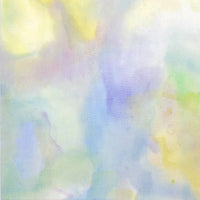Effect pigments come in a wide variety of types, from the one that creates soft glittering to the one that reflects light diffusely like glasses and sequins.
This Astroflake series is a granulated pigment made from high-purity tinted aluminum leaves by cutting them out in even sizes. What makes the Astroflake series stand out among other effect pigments is their rough-textured shiny glitters.
Moreover, the coloring resin used in these pigments has excellent light and water resistance which allows them to maintain their clear and exquisite luster.
As with other effect pigments, the Astroflake series can be used as a paint by mixing the pigments with a binder of your choice. However, due to the large particle size of Astroflake #20, diluting the paint with too much water may weaken its fixing power.
Therefore, please knead the pigments thoroughly with the binder and use it while carefully adjusting the amount of water.
In this article, I have made a few color samples with the color, and let’s take a look at them!
The following chart shows what the Astroflake 12 / Royal Blue #20 actually looks like when painted on paper.
【Art Materials Used】
Color material: Astroflake 12/ Royal Blue #20 (NAKAJIMA METAL LEAF, POWDER Co., Ltd.)
Medium: Gum Arabic Medium (KUSAKABE)
Acrylic Emulsion
As you can see, when mixing Astroflake with Gum Arabic Medium, the color has a slightly matte texture, while when they are mixed with Acrylic Emulsion, it tends to enhance the glossiness of the pigments.
However, since the Astroflake series has large particles and the paint might peel off if the binder isn’t strong enough, it is better to mix the pigments with binders that have appropriately strong adhesiveness.
The top row was painted with a brush and the bottom row was painted with a palette knife. The background will be seen through if you paint it in simply one stroke, so it is necessary to apply several layers of paint, especially with a brush.
And of course, I painted multiple layers for this color sample.
On the other hand, although a palette knife can create a beautiful stroke in one go, it is not suitable for use with binders that are not meant to be creating thicker coats, such as gum arabic.
Naturally, these pigments can be mixed with other pigments too.
For example, mixing colors among the Astroflake series or with other pigments can bring out some interesting colors and unique textures like the ones following samples show.
I personally feel that the Astroflake series appears to be more vibrant after mixing with other pigments rather than only being applied by itself.
Moreover, by mixing with fine-grained transparent colors such as organic pigments (phthalo blue, etc.), which have a lighter specific gravity, it might bring out a totally different kind of texture too.

【Art Materials Used】
Color material: Astroflake 12/ Royal Blue #20,
Astroflake 14/ Violet #20 *Sorry, this item is no longer available.
Crimson Lake(MATSUDA OIL COLOR)
Medium: Acrylic Emulsion
Substrate: Bamboo Washi for Watercolor
Acrylic Emulsion is not the only one with strong adhesion.
Binders like gel mediums are commonly used to create transparent acrylic paints. In the next color sample, I mixed the Astroflake series with Gel Medium, then painted them with a brush.
Gel Medium is a more viscous and transparent binder than acrylic emulsion. It can be used to mix with pigments and make paints, prime a surface to create textures or as a glue for collage making.
Furthermore, Gel Medium can also be used with a brush to make the color of the base material moderately transparent.

【Art Materials Used】
Color material: Astroflake series - all colors
*Sorry, this item is no longer available. -Astroflake 15/ Lavender #20
Medium: Gel Medium (Holbein Art Materials)
Substrate: Bamboo Washi for Watercolor
In general, while making oil or acrylic paints, the impression of pigments will change drastically after mixing with glossy mediums. However, the Astroflake series does not show significant color changes before and after adding the mediums.
In a sense, it is a very simple type of effect pigment. However, if you want to create a more vibrant effect, it is still better to paint it on a dark background.
I hope you enjoy the surprise obtained by mixing colors. You may also mix pigments from different specific gravity to create granulating colors. Although adding a large amount of water to create a granulating effect is necessary, it might weaken the fixing power of the mediums and cause the paint to peel off, so experiment with it first to find the balance.





